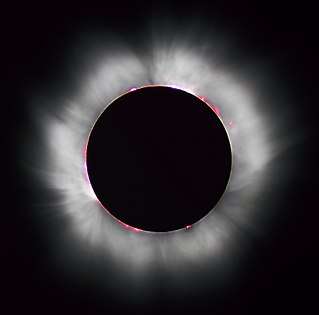1999 in science
The year 1999 in science and technology involved some significant events.
| |||
|---|---|---|---|
Aeronautics
- February 27 – While trying to circumnavigate the world in a hot air balloon, Colin Prescot and Andy Elson set a new endurance record after being in their balloon for 233 hours and 55 minutes.
- March 3–20 – Bertrand Piccard and Brian Jones successfully complete a non-stop circumnavigation of the world in a hot air balloon.
Astronomy and space exploration

Total solar eclipse of August 11, viewed from France
- January 31 – A total penumbral lunar eclipse
- February 7 – Stardust is launched on a mission to collect samples of a comet coma, and return them to Earth.
- February 16 – Annular solar eclipse, visible from Australia.
- July 20 – Mercury program: Liberty Bell 7 is raised from the Atlantic Ocean.
- July 28 – Partial lunar eclipse, visible from Australia, eastern Asia, and western North America.
- July 31 – NASA intentionally crashes the Lunar Prospector spacecraft into the Moon, thus ending its mission to detect frozen water on the moon's surface.
- August 11 – Total solar eclipse, visible from Europe, across the Middle East, and ending in India.
- December 16 – The Beethoven Burst (GRB 991216) is one of the most powerful detected Gamma-ray bursts.
- NASA loses two Mars probes, the Mars Climate Orbiter and the Mars Polar Lander.
- The Subaru 8.3 m and Gemini North 8.1 m reflecting telescopes open at the Mauna Kea Observatory in Hawaii.
- The Cetus Dwarf galaxy is discovered.
Biology
- November 1 – Agreement on the Conservation of African-Eurasian Migratory Waterbirds comes into force.
- Late – Pest-exclusion fence around Zealandia (wildlife sanctuary) in Wellington, New Zealand, completed.
- The bacterium Thiomargarita namibiensis is discovered off the coast of Namibia. At 0.3mm in diameter, it is largest bacteria yet discovered.
Chemistry
- Elements 118 and 116 are claimed to be made for the first time. Later retracted when results could not be replicated.
Computer science
- March 26 – The Melissa worm attacks the Internet.
- June – RFC 2616 defines HTTP/1.1, the version of Hypertext Transfer Protocol in common use.
- September 21 – David Bowie's Hours becomes the first complete music album by a major artist available to download over the Internet in advance of the physical release.[1]
- First working 3-qubit NMR computer demonstrated at IBM's Almaden Research Center. First execution of Grover's algorithm.
- Probable date – First emojis introduced, in Japan.
Geology
- January 25 – A 6.0 Richter scale hits western Colombia, killing at least 1,000.
- August 17 – The 7.6 Mw İzmit earthquake shakes northwestern Turkey with a maximum Mercalli intensity of IX (Violent), leaving 17,118–17,127 dead and 43,953–50,000 injured.
History of science and technology
- Boris Chertok publishes «Ракеты и люди» (Rockets and people), a history of the Soviet rocket program.
Mathematics
- Eric M. Rains and Neil Sloane extend tree counting.[2]
Paleontology
- First fossil of Kenyanthropus Pliocene hominin discovered in Lake Turkana, Kenya.
Physiology and medicine
- Huda Zoghbi demonstrates that Rett syndrome is caused by mutations in the gene MECP2.[3]
Telecommunications
- The first BlackBerry is released, using the same hardware as the Inter@ctive pager 950, and running on the Mobitex network.
Awards
- Nobel Prizes
- Physics – Gerardus 't Hooft, Martinus J.G. Veltman
- Chemistry – Ahmed H. Zewail
- Medicine – Günter Blobel
- Turing Award: Fred Brooks
- Wollaston Medal for Geology: John Frederick Dewey
Deaths
- February 21 – Gertrude B. Elion (b. 1918), American pharmacologist, Nobel laureate in Physiology or Medicine.
- February 25 – Glenn T. Seaborg (b. 1912), American physical chemist, Nobel laureate in Chemistry.
- March 17 – Herbert E. Grier (b. 1911), American electrical engineer.
- April 28 – Arthur Leonard Schawlow (b. 1921), American physicist, Nobel laureate in Physicist.
- May 8 – Edward Abraham (b. 1913), English biochemist.
- May 26 – Waldo Semon (b. 1898), American inventor.
- July 8 – Pete Conrad (b. 1930), American astronaut.
- November 11 – Vivian Fuchs (b. 1908), English geologist and explorer.
- November 25 – Pierre Bézier (b. 1910), French engineer.
gollark: In 30 years I imagine we'll have replaced Rust several times over.
gollark: Clearly, my purchase of a GT 710 several years ago because I needed something which would technically work as a GPU was very foresighted.
gollark: For example, you can call people "utterly isomorphic to the group of integers modulo 7" or "literally made of pentavalent carbon".
gollark: The best insults are ones which are not actually recognizable in any way as insults.
gollark: Is the US not attempting to develop similarly ææææ laws?
References
- Cummings, Sue (1999-09-22). "The Flux in Pop Music Has a Distinctly Download Beat to It". The New York Times. Retrieved 2013-11-01.
- Crilly, Tony (2007). 50 Mathematical Ideas you really need to know. London: Quercus. p. 117. ISBN 978-1-84724-008-8.
- Amir, Ruthie E.; Van den Veyver, Ignatia; Wan, Mimi; Tran, Charles; Francke, Uta; Zoghbi, Huda Y. (1999). "Rett syndrome is caused by mutations in X-linked MECP2, encoding methyl-CpG-binding protein 2". Nature Genetics. 23 (2): 185–8. doi:10.1038/13810. PMID 10508514.
This article is issued from Wikipedia. The text is licensed under Creative Commons - Attribution - Sharealike. Additional terms may apply for the media files.